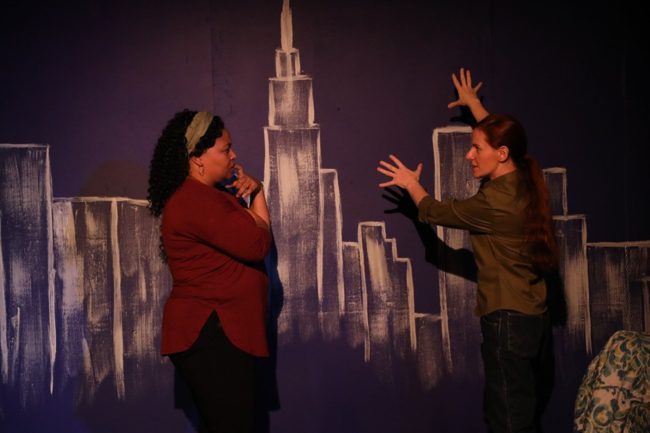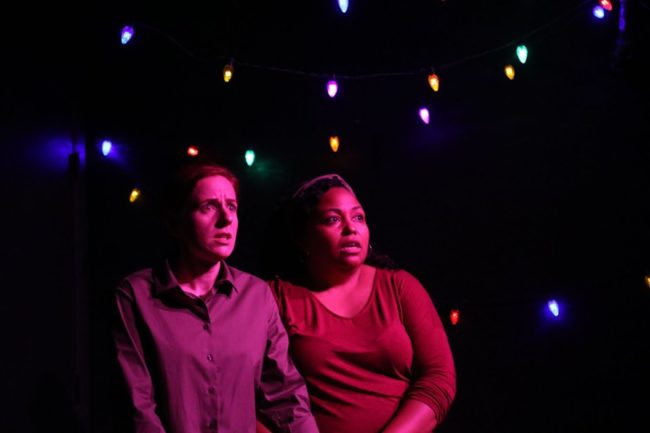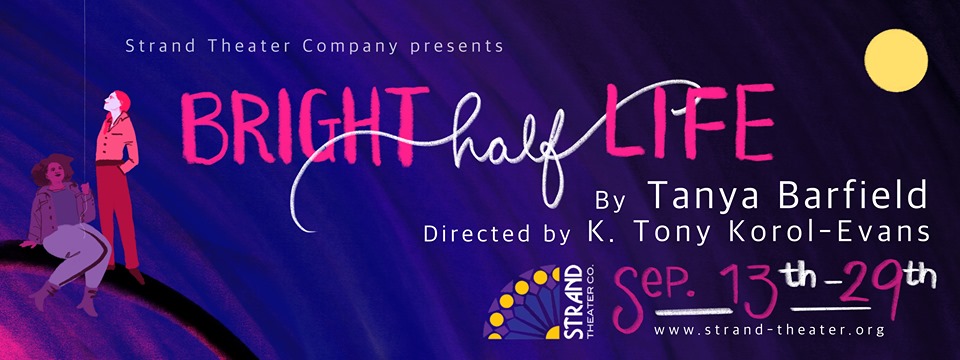When I was considering attending Tanya Barfield’s Bright Half Life, I committed a horrendous crime, in that I read a review containing a summary. A couple starting out like a fire caused by a comet. The marvelous beginning, the slow and painful waning, and an end showcasing the doom that was always in store, as if asking us if it was really worth the good times. Knowing the half-life referred to a relationship and not a radioactive isotope was all I was after! I mention this because even the most thorough comprehension is tinted by the personality and opinions of the viewer, and so it was that I reached into this play and came away with a more hopeful take on what I had seen, suggesting that after a bright half-life is another, perhaps shorter, bright half-life.

The play begins where the romance seems to end, like a stone shattering two people’s lives, and the story is told in bits and pieces, as if the characters are flashing back to the times that mattered. Like two people having an argument, correcting one another, while telling a story, we are taken down each crack of the spiderweb forming in the glass of this relationship, to the sacred start, and back again, but we aren’t sure the location of each moment on the timeline, which adds to suspense. Erica (Katherine Vary) stands at the door in a confrontation with an ex-lover, and much time has passed since they were together, though we aren’t yet aware how much of it, but the tension is thick enough to cut with a knife. This scene seems like our present, as it is truly where these women come to terms with one another. Erica is in the process of losing her father, with a well portrayed need of consolation which Vicky (Avesis Clay) is not yet aware of, so the interaction takes time to warm up. Once the sad news is out in the open, the memories from no particular point of view begin flashing before the audience.
Set Designer and Director K. Tony Korol-Evans triumphed over quite a challenge in putting together a minimalistic set that was just robust enough to allow a couple to lounge in bed, argue in a living-room, ride an elevator, grow closer on a Ferris wheel, and jump out of a plane. This worked flawlessly because Robert Brook’s lighting was in all the right places at all the right times, which allowed Katharine Vary and Ayesis Clay (the two performers of the play) to smoothly transition between scenes that were only a few feet apart on a set that stays the same, while appearing to have leaped time and circumstance. It’s hard to imagine a better example of a brightness change affecting mood. Great care must have been taken to ensure blocking could be changed fast enough for the audience to feel as if we really had cut from scene to scene, like a soap opera flashback.
One theme that was explored frequently in this play was that similarities may draw us together, and differences may push us apart, but we can also complement each other, and whether the difference is a deal-breaker or a chance for the strengths of each one to cover and heal the weaknesses of the other is something that is up to us. Erica (Vary) is believably terrified in the Ferris wheel, but Vicky’s (Clay) compassion and patience allows them to get closer. Her pragmatic approach to life is perhaps balanced by Erica’s spur of the moment lack of plans, which isn’t always appreciated. We need to see the fighting to feel their struggle, and we need to be taken back to the happiest memory, which is why we were shown the same love scene, with no discernable differences, so many times I lost count, but it was clear that the point was to keep us with one foot in heaven and one foot in hell, as a romance can sometimes be; as a relationship with anyone, what love can become.

Life has its ups and downs. When we need to grow attached to these characters, we see the bits of them flirting and coming to know one another, which may remind us of our own lives, but if needing to see things crumble meant sitting through a second half of the play made out of miserable arguments and the worst of two people, I would not have enjoyed myself, so it is wise that the playwright took the unorthodox approach of telling the story in a zig-zag back and forth across the present and past. These actresses are owed praise for being able to take the jump between good and bad times as believably as they did. What also deserves credit is that a scene we saw many times, each portrayal a little longer and closer to a meaningful conclusion than the last, ended up being the true present. What would have been a future they never got to share was actually the point the play ends on, and they do get to share it, because despite the lows, these two friends are still there for each other and have adapted and grown; still holding hands as the sun sets. It may have been a bright half-life, but the final scene shows that it actually was a whole life.
Running Time: Approximately 75 minutes with no intermission.
Bright Half Life plays through September 29, 2019 at The Strand Theatre— 5426 Harford Road in the Hamilton neighborhood of Baltimore, MD. For tickets, call the box office at (443) 874-4917 or purchase them online.

